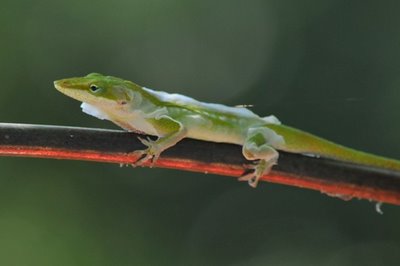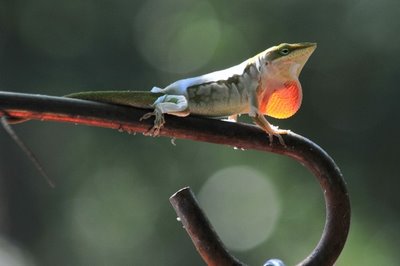For the past six weeks, a small fracture in one foot has kept me from taking my usual daily walks – as well as from field trips and walks in the woods – so most of my birding has been restricted to around our house and yard. This morning about 8:15, I drove up to the Old Field that runs along the dead-end road just outside our subdivision. I wanted to see if the Blue Grosbeaks, Indigo Buntings, Yellow-breasted Chats and Field Sparrows had returned this spring.
When I first got out of my pickup, the traffic noise from nearby Highway 441 was so loud I didn’t think I was likely to see or hear anything but trucks, SUVs, cars and more trucks. But despite the traffic, I almost immediately heard the song of a White-eyed Vireo, then an Eastern Towhee, Blue-gray Gnatcatcher, and Phoebe. Three or four Mockingbirds sat quietly on a wire, but I didn’t see the Red-tailed Hawk that often sits out on one of the utility poles along the power cut that runs through the field.
Red-spotted Purple and Sleepy-orange Butterflies flew among the purple thistles that spread over several open areas of the field, the purple blooms turning into white fluffs of seeds. In the ditches and grassy areas, Queen Anne’s lace bloomed dusty white. Large areas of the field have now grown up in pines, sweet gums, chinaberrys and other trees. The more open areas are choked with thickets of privet and blackberry vines, and tall, rough grasses.
I was watching a Brown Thrasher in some privet when I heard it – the song of a Blue Grosbeak. And there he was, perched in the very top of one of the tallest trees in that part of the field – maybe a wild cherry – singing and singing. A small dark bird with a slightly crested head, he didn’t look blue at first, but I could see the rusty-orange wing bars, and the big silver beak gleamed as it caught the light and parted every time he tilted his head back to sing. For several minutes he sang from the same perch, pausing now and then to preen, lifting one wing and then the other, spreading his tail feathers. But never more than a few seconds passed before he lifted his head and sang again.
A Blue Grosbeak’s song is usually described as a long, rich, finch-like warble. In addition, what I recognize most quickly is the distinctive rhythm and the way it always crests in a certain high note roughly in the middle of the song. To me it sounds joyous, full of optimism and a sunny, persistent spirit – reflecting, as many bird songs do, the habitat in which it lives. In this case, the Blue Grosbeak is one of many plant and animal species that colonize rough, abused places like old fields and help bring them back to life.
Finally, he flew to another treetop only a few yards away, again perching in the very top, and continued to sing and preen for several more minutes, and from this different angle the blue of his back ran like a wide ribbon between the darker wings. At the same time, a Gray Catbird was singing and mewing from somewhere deep in the foliage of a chinaberry tree. I listened also for the sharp, metallic
tink that might be a female Grosbeak calling, but I didn’t see or hear one.
After walking further along the field and finding no buntings, no field sparrows, no chats, I had just about decided to be happy to have found the Grosbeak when I saw a small dark ball hurtle across the road into the dense privet thickets along the power cut. I thought it was only wishful thinking when I said, “Indigo Bunting” – but then I heard its bright, clear
sweet-sweet, chew-chew, sweet-sweet song.
I heard no Field Sparrow and no Yellow-breasted Chat, but was only there for about 45 minutes on one rather noisy-traffic morning. So I wouldn’t say for sure. And it was certainly encouraging to find both Blue Grosbeak and Indigo Bunting singing, and a good number of other bird species active. A Robin and one Mockingbird were singing, and I also saw or heard Chickadees, Titmice, Carolina Wren, Cardinals, Chimney Swifts, Goldfinch, Brown-headed Cowbird, Mourning Doves, two Black Vultures and one Turkey Vulture soaring, and a House Finch family feeding in the purple thistles.


